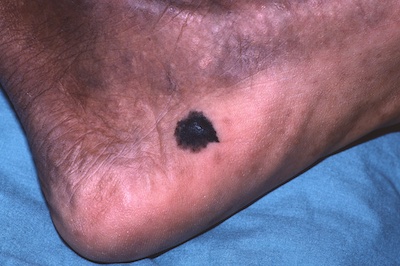Hit the beach with your pale-skinned friends, and they’ll likely want to slather on some sunscreen before beachcombing and body surfing. For your friends of color, however, sunscreen may never make it out of the beach bag.
Studies show that minority populations, particularly people are Hispanic or Black, take fewer steps to protect themselves from the sun and are less likely to wear sunscreen.
Sun Damage, Sunburn, and Skin Cancer In People of Color
We talked with UVA Health surgical oncologist Russell Witt, MD, who treats melanoma. He set the record straight on common myths that may keep people of color from protecting themselves from the sun.
Myth: The Sun Doesn’t Damage Dark Skin
Fact: Sun damage — including sunburn — happens no matter what color the skin. To understand why, let's look at our skin makeup.
Melanocytes, or cells that make melanin (the substance in skin that gives off color), work differently in different skin types. In pigmented skin, those cells make more melanin and in bigger clumps. This melanin absorbs the sun’s rays before they can damage the cell’s DNA.
In light-colored skin, these melanocytes make fewer and smaller clumps of this pigment. That makes it easier for sunlight to get through to damage the cells’ DNA.
Any time you get a sunburn, that’s a sign of damage to the DNA. Even a tan is a sign that your body is trying to adapt to an insult. In other words, there’s no such thing as a healthy tan.
"Although dark skin has more melanin, which provides some protection against UV radiation, it is still susceptible to sunburn, photoaging, and at risk of skin cancer," Witt explains. Darker skin may not show these visible signs of sun damage as readily. But it’s still happening.
When sunlight penetrates cells, UV radiation damages the cell’s DNA, which makes up the body’s basic blueprint for growing new cells and structures. As a result, you get an overgrowth of atypical cells that the body is less equipped to recognize and destroy.
Myth: People With Dark Skin Don’t Need to Wear Sunscreen
Fact: Sunscreen provides added protection against the UV rays that can cause skin cancer and is recommended for all skin types. Sunscreen increases the skin’s natural resistance to sun damage by absorbing and reflecting sunlight.
"Sunscreen helps prevent UV damage, which can lead to skin cancer, hyperpigmentation, and premature aging," Witt says.
Myth: Skin Cancer in People of Color Is Less Common
Fact: It's true skin cancer is more common in those with lighter skin. But people of color are more likely to die of the disease.
Skin cancer in people of color "is often diagnosed at a later stage and can be more aggressive," Witt shares. "Acral melanoma, one of the most aggressive types, is more common in people of color."
Many darker-skinned patients think they won’t get skin cancer. So by the time they see a provider for a suspicious spot, the cancer is more advanced and difficult to treat.
Myth: Skin Cancer Looks the Same in All Skin Types
Fact: Skin cancer symptoms differ depending on the type of cancer and skin color. Not sure what to look for? These are the three most common types of skin cancer in people of color.
Squamous Cell Carcinoma
Squamous cell carcinoma is the most common cancer in darker skin. Two things can cause it: Sun exposure and the human papillomavirus (HPV). If you have a compromised immune system, you’re at greater risk for both UV radiation and HPV-induced skin cancers.
In pale skin, this cancer pops more often in sun-exposed areas like the back of the arms, top of the hands, the tops of the ears, or on a bald scalp.
Darker skin can get squamous cell in these places as well. But you’re most likely to see it:
- In the genital area or another site not typically exposed to the sun
- In an area with chronic scarring due to a condition like lupus
Squamous cell carcinoma symptoms include:
- A painful or tender bump
- A growing warty lesion in the genital area
- A sore that fails to heal
- Thick scaly patches that crust or bleed
Basal Cell Carcinoma
Basal cell carcinoma looks basically the same in all skin colors. The signs of basal cell in darker skin include a non-painful bump that:
- Is translucent in appearance
- Bleeds easily
- Has flecks or globules of pigment, like a dark marble suspended in gelatin
Most of cases of basal cell carcinoma in pigmented skin are directly related to sun exposure.
Melanoma

Melanoma isn’t as common as other skin cancers. But it’s the most deadly because it can spread rapidly to other organs. That’s why early detection is so important. However, people of color, in particular, may not notice this cancer because they're unsure what to look for.
On white skin, melanoma most commonly appears on the back or on the lower legs as a dark spot that is changing colors or growing. But people with pigmented skin get melanoma in different places like the palms, soles of the feet, lips, and fingernails.”
Reggae music legend Bob Marley, for example, had a type of melanoma that first showed up under the nail of his big toe. There’s less pigment in these areas of the skin. That is one explanation. But genetics can play a role. So if a family member had melanoma, you should be extra careful about looking for signs of skin cancer.
If you have darker skin, watch for these common melanoma symptoms:
- New or changing dark spot (brown, black or tan), especially on the soles or palms, that is asymmetrical and has an irregular border
- A darker line in the nail that is wider than 3mm, especially if it is wider at the cuticle, splitting, and causing damage to the nail
- A dark spot on the lips that grows or changes
Spots may start off flat, but then become raised.
Myth: People of Color Don’t Need Regular Skin Cancer Screening
Fact: Everyone, regardless of skin color, should see a dermatologist.
"Regular screenings are important because early detection of skin cancer significantly improves treatment outcomes and can save lives," Witt says.
How often? That varies depending on your family history and skin type. For people of color, experts recommend a baseline screening around age 20. If there are no concerns, have a follow-up appointment every 2-3 years.
Get a Skin Cancer Screening
A UVA Health dermatologist can help you catch skin cancer earlier when it's easier to treat.
How to Protect Darker Skin
Regardless of your skin color, sun protection will lower your risk for cancer. If that’s not enough of an incentive, keep in mind that those pesky UV rays also cause signs of aging like fine lines, wrinkles and age spots.
Here’s how to ensure your skin remains protected and retains that youthful glow:
- Use a broad-spectrum sunscreen that’s at least SPF 30 or higher. Apply every 2 hours when you’re out in the sun.
- If you're in the water, be sure to choose waterproof or water-resistant sunscreen, and follow instructions about reapplying after swimming.
- Avoid peak hours when the sun’s rays are strongest — between 10 a.m. and 2 p.m.
- Wear photoprotective clothing.
- Don’t forget a hat and sunglasses.
Worried about your sunscreen leaving a white cast? Chemical sunscreens, especially international sunscreens made outside the U.S., are less likely to leave behind a white residue. Witt notes that these "can be a good option."
"In the U.S., the FDA regulates sunscreen as an over-the-counter drug, while most international countries regulate it as a cosmetic," he says. Many international sunscreens use newer filters not approved in the U.S. That allows companies to create different formulas, including some that leave no white cast.
"Purchasing international sunscreens carries some risks, as the lack of U.S. regulations means there’s no guarantee of authenticity," Witt shares.
Most importantly: Pay attention to your skin! Talk to your doctor if you have any questions about even minor skin changes.



It’s common knowledge and practice that non-white-skinned (eg brown, black) people all over the world do not use skin protection even routinely (i.e. lots of times not at all) b/c it’s not a way of life. What do statistics show (if there are any) in comparing skin affliction (e.g. cancer) in white-skinned v non-white skinned populations the world over? I’m assuming there must be a big difference. Haven’t read anything scientific/medical that seriously says that “non-whites” must use skin protection b/c of any known alarming situation. Please note that statistics world-wide will tell a true story, not anything regional. Thanks very much. (I’m a former medical doctor).